Article Written December 7, 2014 by Melissa Ott.
The history of the tanoak tree in Santa Cruz reaches back to the beginning of time, when local Ohlones--the Uypi of present-day Santa Cruz, and their neighbors the Aptos, Cotoni, and Sayanta--used it for food and other purposes.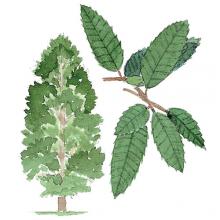 It also featured prominently in the lives of the early non-Indian in this region who lived in the towns we know of today, such as Santa Cruz and Scotts Valley. These Euro-American newcomers used the tanoak tree bark for tanning hides into leather, an industry which continued until the present century in Santa Cruz County. In this article, we explore these histories, as well as examine the tanoak tree itself and its current threat from Sudden Oak Death so that hikers, bikers, and horse riders can identify tanoak and avoid spreading this disease among trees in our forests.
It also featured prominently in the lives of the early non-Indian in this region who lived in the towns we know of today, such as Santa Cruz and Scotts Valley. These Euro-American newcomers used the tanoak tree bark for tanning hides into leather, an industry which continued until the present century in Santa Cruz County. In this article, we explore these histories, as well as examine the tanoak tree itself and its current threat from Sudden Oak Death so that hikers, bikers, and horse riders can identify tanoak and avoid spreading this disease among trees in our forests.
An Early Observation
In 1846, an American, John C. Fremont passed through the forested Santa Cruz Mountains, which would become the homesteads of non-Indians in the 1850s (Young 93). Though comparatively few people lived in the mountains at the time, the tanning industry had begun three years earlier in Scotts Valley, the beginning of an era of leather making and associated logging of tanoak trees (Lehmann).
Fremont wrote in his journal about what he observed as he traveled through the Santa Cruz coastal mountain range, and unsurprisingly this included many descriptions of trees. One entry describes “a handsome, lofty evergreen tree, specifically different from those of the lower grounds, and in the general appearance much resembling hickory. The bark is smooth, of a white color, and the wood hard and close-grained. It seems to prefer the north hillsides, where they are nearly four feet in diameter and 100 feet high” (Young 93).
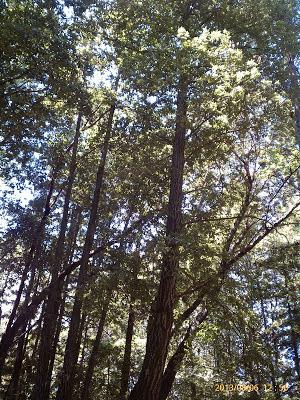
Picture from Trees of Santa Cruz County
Writer John V. Young in Ghost Towns of the Santa Cruz Mountains suggests that Fremont was describing the tan-bark oak, or tan oak, Notholithocarpus densiflora. This tree, often mistaken for an oak despite being only a relative of the oak genus, was “a major source of revenue for mountain people for half a century, when tanning hides was a major industry” (Young 93). The old tannery building on River Street that was recently converted into the Tannery Arts Center is a relic of the industry that once generated enormous revenue for this region. Its economic success came at the cost of environmental loss; tanoak tree bark in our forests provided the tannin needed to turn hides into leather.
Properties and Ohlone Uses of the Tanoak Tree
Writer John V. Young in Ghost Towns of the Santa Cruz Mountains suggests that Fremont was describing the tan-bark oak, or tan oak, Notholithocarpus densiflora. This tree, often mistaken for an oak despite being only a relative of the oak genus, was “a major source of revenue for mountain people for half a century, when tanning hides was a major industry” (Young 93). The old tannery building on River Street that was recently converted into the Tannery Arts Center is a relic of the industry that once generated enormous revenue for this region. Its economic success came at the cost of environmental loss; tanoak tree bark in our forests provided the tannin needed to turn hides into leather. Properties and Traditional Uses of the Tanoak Tree Found along the Monterey Bay and along the west coast of California, the tanoak tree has “yellow green flowers” that blossom in the springtime, from May until June (Casterson 104). Perhaps you’ve seen these trees on strolls through our redwood forests in Santa Cruz.
In Sierra Club member David Casterson’s book In the Company of Redwoods, he describes the flowers as “similar to chestnuts” and explains that they are related genetically to both chestnuts and oak. When the flowers are blooming, the tanoak has “light green and shiny” leaves that are “wooly” underneath. As the season progresses, the wooly side loses its hairs and turns white. The tree, like oak trees, produces acorns that take a couple of years to mature.
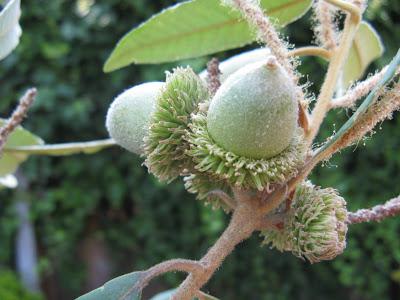
Source: Trees of Santa Cruz County
These acorns, like specific species of oak acorns throughout most of present-day California, were used, and continue to be used as food by thefirst people of this region. Prepared variously by California Indians as soup, a thicker mush, “biscuits,” and bread, acorns, along with the seeds of native grasses and forbs, provided a carbohydrate-rich food that could be stored throughout the year. The Kashaya Pomo of the present-day Fort Ross area called, and continue to call, the tanoak “chishkale,” which means “beautiful tree” (Casterson 104; Ortiz, pers. comm. 2014).
Beverly Ortiz, Cultural Services Coordinator for East Bay Regional Park District, shared via email a summary of Ohlone plant uses for tanoak trees from an article by Barbara Bocek, based on 1920s and 1930s interviews by J.P. Harrington with Ohlones Ascencion Solorsano and Isabel Meadows: the tanoak’s “Old California Spanish” name was ‘cascalote’ and its Rumsen (Monterey area) and Mutsun (San Juan Bautista area) name ‘xoppow.’” Rumsen and Mutsun are two Ohlone languages, spoken in the “Upper Santa Clara Valley, the Pajaro River drainage and the lower Carmel and Salinas River valleys” (Bocek 240).
Of all the acorn-producing plants in this area, tanoak is preferred for food by some contemporary Ohlones (Ortiz 2008). As for its known Ohlone uses, the bark of the tanoak could be made into a dye, “a liquid held in mouth to tighten loose teeth,” and “a wash for face sores” (Bocek 248). Its wood was also a favorite for pit-oven cooking among some California Indians, because it is a hardwood like oaks (Ortiz 2008). Though not an extensive amount of information exists in the present day about Ohlone use for the tanoak, there are more records of its use by people from other regions in California. This information is available in more detail in the documents of the Works Cited.
Tanning Industry History
In the many years of the tanning industry in this county, countless tanoak trees were cut down or shed of their bark for use in tanning hides into leather. Ghost Towns of the Santa Cruz Mountains includes an entry from the Pacific Coast Business directory of 1867 describing the tanning industry at the time: “Owing to the large size, heavy and firm character of the hides of the cattle slaughtered here (Santa Clara Valley), the sole leather manufactured here is superior to that produced in the tanneries of the eastern states. The bark of the peculiar species of oak (Lithocarpus densiflora) found along the coast from Monterey Bay to Mendocino, and particularly in the Santa Cruz Mountains, noted for its excess of tannin, is peculiarly adapted to this purpose, and many of the ancient denizens of the soil have been stripped bare to serve this important end” (Young 107-108). (Note: According to David Casterson, since Young’s book was written, the tanoak's scientific name has been changed to Notholithocarpus densiflora, which is based on DNA testing, hence the use of this name elsewhere in this article.)
From 1843 until 2001, with a few gap years when operations slowed, Santa Cruz County tanneries turned hides into leather products, using tannins from tanoak bark, though to a lesser degree as new chemicals for tanning were used. The former Salz Tannery on River Street was originally the Grove Tannery, founded by William Warren and James Duncan in 1856. But it wasn’t the only tannery in the county at that time (Lehmann). A statement written by Susan Lehmann for the City of Santa Cruz Planning and Development Department states that in 1857, there were four tanneries in Santa Cruz, which “were able to tan and dress ten thousand hides a year. In addition, the Santa Cruz County manufacturers had established outlets in San Francisco for leather goods that included skirting, harness, belting, bridle and sole leather” (Lehmann).
At this level of output, though, “prodigious amounts of tan bark” had to be used. “Not just the bark but the entire tree was harvested and used for barrel staves as well as firewood to produce steam to run the plants. Although the supply seemed endless, by the turn of the century the oak trees, like the redwoods used for lumber and to fuel the limekilns, were seriously depleted, bringing about the eventual demise of the industries they had created” (Lehmann).
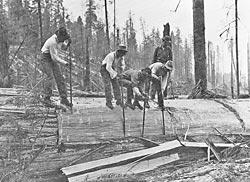
Source: Mendorailhistory.org
A diagram in Willis Linn Jepson’s book Tanbark Oak and the Tanning Industry shows the number of cords of tanoak used for tanning in California from the years 1851-1907, with 4-6 trees per cord. The number of cords per year increased over time to add up to a total of 1,722,000 tanoak cords used in that 57 year timeframe. Estimating on the low end at 4 trees per cord, that adds up to 6,888,000 trees felled in California for tanning leather, just within the dates listed (Jepson 5-10).
Tanoaks Today and Sudden Oak Death
Over time, methods for tanning hides became less dependent upon tanoak bark and turned to other materials. Today, there is no tanning industry in Santa Cruz, and the only obvious evidence of its existence is in the name of the arts center that has replaced the Salz Tannery, the Tannery Arts Center. This combination art studio, housing, and café center has a history exhibit on display about the history of tanning in Santa Cruz. The newer growth of tanoak trees in our forests are another form of evidence.
Today, these trees can be found in many places in the County, often near Coast Redwoods (Sequoia sempervirens) and growing 17-30 meters, or 55-98 feet, tall (Casterson 104). One example of a place you can see these trees is along the dirt road in Nisene Marks State Park on the way to the Porter Family Picnic Area; however, hikers and mountain bikers should be careful to avoid spreading Sudden Oak Death (Phytophthora ramorum), a contemporary threat to the tan oak and oak trees throughout California and Oregon.
According to Wikipedia, Sudden Oak Death (SOD) “was first discovered in California in 1995 when large numbers of tanoaks (Lithocarpus densiflorus) died mysteriously […] In tanoaks, the disease may be recognized by wilting new shoots, older leaves becoming pale green, and after a period of two to three weeks, foliage turns brown while clinging to the branches. Dark brown sap may stain the lower trunk's bark. Bark may split and exude gum, with visible discoloration. After the tree dies back, suckers will try to sprout the next year, but their tips soon bend and die. Ambrosia beetles (Monarthrum scutellare) will most likely infest a dying tree during midsummer, producing piles of fine white dust near tiny holes. Later, bark beetles (Pseudopityophthorus pubipennis) produce fine red boring dust. Small black domes, the fruiting bodies of the Hypoxylon fungus, may also be present on the bark. Leaf death may occur more than a year after the initial infection and months after the tree has been girdled by beetles.”
The loss of tanoaks to this disease has not only ecological effects, but also cultural ramifications for the Native people who have relied on tanoak acorns as a culturally and spiritually important food source for thousands of years. Beverly Ortiz describes in a 2008 article about “Contemporary California Indians, Oaks and Sudden Oak Death,” “Since July of 2000, when researchers identified the cause of unusual levels of tanoak die offs in Mill Valley, Santa Cruz and Monterey as SOD, California Indians have had to grapple with a new and wide-ranging threat to cultural survival. Not only does this disease kill particular species of acorn-producing trees, but two of those species, black oak and tanoak, are the most valued acorn-producing species used by California Indians statewide today. […] Of the 23 native plant species and one genera that have been designated as regulated hosts for SOD as of September 11, 2006, and the 18 other associated native plant species that may soon follow as regulated hosts, the author has identified contemporary cultural uses for all but 12. This does not mean, of course, that those 12 lack contemporary cultural uses, but only that such uses have not been identified. Additional, as yet unidentified, cultural uses may also exist for the others.”
There are both natural, non-human causes of its transmission, as well as directly human-related reasons why this disease spreads in forests. The disease can be transmitted when infected rainwater travels from one plant to another, either in nearby areas or traveling along waterways to plants downstream. Human causes of transmission include the movement of ornamental plants that are hosting the disease and walking, mountain biking, riding horses, or otherwise travelling through areas with this disease in the surrounding trees. “Those travelling in an area known to be infested with SOD can help prevent the spread of the disease by cleaning their (and their animal's) feet, tires, tools, camping equipment, etc. before returning home or entering another uninfected area, especially if they have been in muddy soil. Additionally, the movement of firewood could serve as a vector for sudden oak death, so both homeowners and travelers alike are advised to buy and burn local firewood” (Wikipedia). We each have the ability to protect our forests, including tanoaks, from Sudden Oak Death. When we travel into or out of the forest, we must be mindful of what we’re bringing with us, often unintentionally.
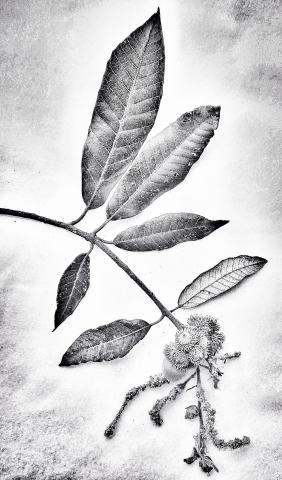
(Image Source: Casterson p. 105)
The next time you see one of these beautiful trees, remember their history in our county--from their use as a culturally vital food and medicine source, to their sacrifice for the production of leather goods, and finally, to the present day, where they live and serve our local ecosystem as members of our forest habitats. Consider passing this article along to a friend or simply sharing the importance of cleaning our shoes, bicycles, and other implements that may be carrying Sudden Oak Death after our adventures in the woods so that we can support the continued existence of tanoaks in our Santa Cruz forests.
=================================================================================
The tanoak tree plant can be found among many others in a unique book called In the Company of Redwoods: An InterActive Guide to Learning 50 Redwood Community Plants through Hand Tinting by David Casterson, a long-time Sierra Club member and former Santa Cruz Sierra Club Executive Committee Chair. The book “enables you to use your inner artist and observation skills to discover and learn Redwood community plants. Its exquisitely detailed black and white photographs are made for you to color” using watercolor pencils. The website has sample pages, color galleries that provide suggested tintings, and a way to order your own copy.
Works Cited
- Bocek, Barbara R. “Ethnobotany of Costanoan Indians, California Based on Collections by John P. Harrington.” Economic Botany, Vol. 38, No. 2 (Apr – Jun., 1984), pp. 240-255.
- Casterson, David. In the Company of Redwoods: An InterActive Guide to Learning 50 Redwood Community Plants through Hand Tinting. Aptos: Natural Sight Press, 2004. Print. Pages 104-105.
- Jepson, Willis Linn.Tanbark Oak and the Tanning Industry. Cambridge: Harvard University, 1911. Print (Digitized). Pages 5-10.
- Lehmann, Susan. “Industrial Development: Tanneries.” Fully Developed Context Statement for the City of Santa Cruz. 2001. Santa Cruz Public Libraries. Web.
- Ortiz, Beverly R. “Cultural Handout: Contemporary California Indians, Oaks and Sudden Oak Death (Phytophthora ramorum)).” General Technical Reports 217, pp. 39-56. U.S. Forest Service Pacific Southwest Region. 2008
- Ortiz, Beverly. "RE: I Have a Friend Seeking Information." Message to Kanyon Sayers-Roods. 2 Dec. 2014. E-mail.
- Wikipedia contributors. "Phytophthora ramorum." Wikipedia, The Free Encyclopedia. Wikipedia, The Free Encyclopedia, 7 Dec. 2014. Web. 8 Dec. 2014.
- Young, John V. Ghost Towns of the Santa Cruz Mountains. 1934. Santa Cruz: Western Tanager Press, 1984. Print. Page 93-108.
Special thanks to Kanyon Sayers-Roods and Beverly Ortiz for connecting me with information about Sudden Oak Death and traditional tanoak tree use by the first people of this land. Thank you also to Sierra Club members who contributed ideas to this article.
Additional Information
- Boerner, Heather. “Salz Leathers Folds Up Shop: Landmark Business to Close this Year.” Santa Cruz Sentinel. 2001. Web.
- Ocean, Suellen. Acorns and Eat ‘Em. CaliforniaOaks.org. 2006. Web.
- Shaw, Peter. “Lithocarpus densiflorus - Tan Bark Oak.” 2013. Trees of Santa Cruz County.
- “Tanbark Oak.” Mendocino Coast Model Railroad & Historical Society.